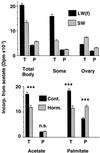Differential lipid biosynthesis underlies a tradeoff between reproduction and flight capability in a wing-polymorphic cricket
- PMID: 12486227
- PMCID: PMC139229
- DOI: 10.1073/pnas.262533999
Differential lipid biosynthesis underlies a tradeoff between reproduction and flight capability in a wing-polymorphic cricket
Abstract
The biochemical basis of life-history tradeoffs is a poorly studied aspect of life-history evolution. We used radiotracer and endocrine approaches to investigate the extent to which morphs of a wing-polymorphic insect differ in the biosynthesis of lipid classes important for dispersal capability vs. reproduction (ovarian growth). The flight-capable genotype of Gryllus firmus biosynthesized a greater amount of total lipid and triglyceride (main flight fuel), which was preferentially allocated to somatic tissue during early adulthood. By contrast, the flightless genotype biosynthesized a significantly greater amount of phospholipid (important in egg development), which was preferentially allocated to ovaries. Topical application of a juvenile-hormone mimic to the flight-capable morph caused it to express all aspects of lipid metabolism seen in the flightless morph. Differences in biosynthesis between morphs (i) occur coincident with 100-400% greater ovarian growth in the flightless morph, (ii) result from alterations of both de novo biosynthesis of fatty acid and downstream partitioning of fatty acids into triglyceride vs. phospholipid, and (iii) possibly result from genetically polymorphic hormonal regulators with negative pleiotropic effects on lipid biosynthesis and ovarian growth. The present study provides direct documentation of genetically based alterations of in vivo flux through pathways of intermediary metabolism leading to the differential production of end products central to the specialization of phenotypes for alternate life histories.
Figures



Similar articles
-
Morph-dependent fatty acid oxidation in a wing-polymorphic cricket: implications for the trade-off between dispersal and reproduction.J Insect Physiol. 2003 Oct;49(10):933-43. doi: 10.1016/s0022-1910(03)00152-5. J Insect Physiol. 2003. PMID: 14511826
-
Biochemical basis of specialization for dispersal vs. reproduction in a wing-polymorphic cricket: morph-specific metabolism of amino acids.J Insect Physiol. 2006 Jun;52(6):646-58. doi: 10.1016/j.jinsphys.2006.03.003. Epub 2006 Mar 12. J Insect Physiol. 2006. PMID: 16643945
-
The endocrine-genetic basis of life-history variation: the relationship between the ecdysteroid titer and morph-specific reproduction in the wing-polymorphic cricket Gryllus firmus.Evolution. 2001 Mar;55(3):538-49. doi: 10.1554/0014-3820(2001)055[0538:tegbol]2.0.co;2. Evolution. 2001. PMID: 11327161
-
Evolutionary Endocrinology of Hormonal Rhythms: Juvenile Hormone Titer Circadian Polymorphism in Gryllus firmus.Integr Comp Biol. 2016 Aug;56(2):159-70. doi: 10.1093/icb/icw027. Epub 2016 Jun 1. Integr Comp Biol. 2016. PMID: 27252212 Review.
-
Evolutionary genetics of juvenile hormone and ecdysteroid regulation in Gryllus: a case study in the microevolution of endocrine regulation.Comp Biochem Physiol A Mol Integr Physiol. 2006 Jul;144(3):365-79. doi: 10.1016/j.cbpa.2005.11.026. Epub 2006 Mar 29. Comp Biochem Physiol A Mol Integr Physiol. 2006. PMID: 16564716 Review.
Cited by
-
Advancements and Future Prospects of CRISPR-Cas-Based Population Replacement Strategies in Insect Pest Management.Insects. 2024 Aug 30;15(9):653. doi: 10.3390/insects15090653. Insects. 2024. PMID: 39336621 Free PMC article. Review.
-
Effects of Flight on Reproductive Development in Long-Winged Female Crickets (Velarifictorus aspersus Walker; Orthoptera: Gryllidae) with Differences in Flight Behavior.Insects. 2023 Jan 12;14(1):79. doi: 10.3390/insects14010079. Insects. 2023. PMID: 36662007 Free PMC article.
-
Insect ATP-Binding Cassette (ABC) Transporters: Roles in Xenobiotic Detoxification and Bt Insecticidal Activity.Int J Mol Sci. 2019 Jun 10;20(11):2829. doi: 10.3390/ijms20112829. Int J Mol Sci. 2019. PMID: 31185645 Free PMC article. Review.
-
The chromosome-scale reference genome of mirid bugs (Adelphocoris suturalis) genome provides insights into omnivory, insecticide resistance, and survival adaptation.BMC Biol. 2023 Sep 19;21(1):195. doi: 10.1186/s12915-023-01666-3. BMC Biol. 2023. PMID: 37726763 Free PMC article.
-
Change in geomagnetic field intensity alters migration-associated traits in a migratory insect.Biol Lett. 2020 Apr;16(4):20190940. doi: 10.1098/rsbl.2019.0940. Epub 2020 Apr 29. Biol Lett. 2020. PMID: 32343935 Free PMC article.
References
-
- Reznick D. N. (1985) Oikos 44, 257-267.
-
- Stearns S. C., (1992) The Evolution of Life Histories (Oxford Univ. Press, Oxford).
-
- Roff D. A., (2002) Life-History Evolution (Sinauer, Sunderland, MA).
-
- Tinkle D. W. & Hadley, N. F. (1975) Ecology 56, 427-434.
-
- Pianka E. R. (1981) in Physiological Ecology: An Evolutionary Approach to Resource Use, eds. Townsend, C. R. & Calow, P. (Blackwell, Oxford), pp. 300–314.
Publication types
MeSH terms
Substances
LinkOut - more resources
Full Text Sources

